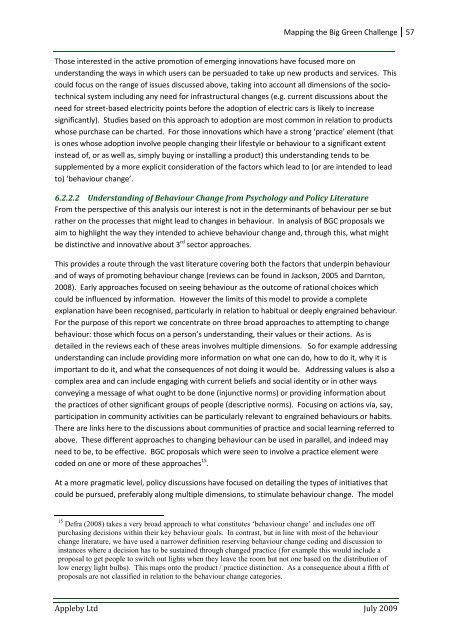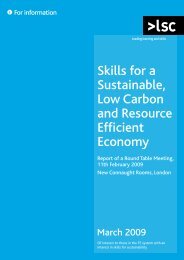Mapping the Big Green Challenge - The Skills & Learning ...
Mapping the Big Green Challenge - The Skills & Learning ...
Mapping the Big Green Challenge - The Skills & Learning ...
Create successful ePaper yourself
Turn your PDF publications into a flip-book with our unique Google optimized e-Paper software.
<strong>Mapping</strong> <strong>the</strong> <strong>Big</strong> <strong>Green</strong> <strong>Challenge</strong> 57Those interested in <strong>the</strong> active promotion of emerging innovations have focused more onunderstanding <strong>the</strong> ways in which users can be persuaded to take up new products and services. Thiscould focus on <strong>the</strong> range of issues discussed above, taking into account all dimensions of <strong>the</strong> sociotechnicalsystem including any need for infrastructural changes (e.g. current discussions about <strong>the</strong>need for street-based electricity points before <strong>the</strong> adoption of electric cars is likely to increasesignificantly). Studies based on this approach to adoption are most common in relation to productswhose purchase can be charted. For those innovations which have a strong ‘practice’ element (thatis ones whose adoption involve people changing <strong>the</strong>ir lifestyle or behaviour to a significant extentinstead of, or as well as, simply buying or installing a product) this understanding tends to besupplemented by a more explicit consideration of <strong>the</strong> factors which lead to (or are intended to leadto) ‘behaviour change’.6.2.2.2 Understanding of Behaviour Change from Psychology and Policy LiteratureFrom <strong>the</strong> perspective of this analysis our interest is not in <strong>the</strong> determinants of behaviour per se butra<strong>the</strong>r on <strong>the</strong> processes that might lead to changes in behaviour. In analysis of BGC proposals weaim to highlight <strong>the</strong> way <strong>the</strong>y intended to achieve behaviour change and, through this, what mightbe distinctive and innovative about 3 rd sector approaches.This provides a route through <strong>the</strong> vast literature covering both <strong>the</strong> factors that underpin behaviourand of ways of promoting behaviour change (reviews can be found in Jackson, 2005 and Darnton,2008). Early approaches focused on seeing behaviour as <strong>the</strong> outcome of rational choices whichcould be influenced by information. However <strong>the</strong> limits of this model to provide a completeexplanation have been recognised, particularly in relation to habitual or deeply engrained behaviour.For <strong>the</strong> purpose of this report we concentrate on three broad approaches to attempting to changebehaviour: those which focus on a person’s understanding, <strong>the</strong>ir values or <strong>the</strong>ir actions. As isdetailed in <strong>the</strong> reviews each of <strong>the</strong>se areas involves multiple dimensions. So for example addressingunderstanding can include providing more information on what one can do, how to do it, why it isimportant to do it, and what <strong>the</strong> consequences of not doing it would be. Addressing values is also acomplex area and can include engaging with current beliefs and social identity or in o<strong>the</strong>r waysconveying a message of what ought to be done (injunctive norms) or providing information about<strong>the</strong> practices of o<strong>the</strong>r significant groups of people (descriptive norms). Focusing on actions via, say,participation in community activities can be particularly relevant to engrained behaviours or habits.<strong>The</strong>re are links here to <strong>the</strong> discussions about communities of practice and social learning referred toabove. <strong>The</strong>se different approaches to changing behaviour can be used in parallel, and indeed mayneed to be, to be effective. BGC proposals which were seen to involve a practice element werecoded on one or more of <strong>the</strong>se approaches 15 .At a more pragmatic level, policy discussions have focused on detailing <strong>the</strong> types of initiatives thatcould be pursued, preferably along multiple dimensions, to stimulate behaviour change. <strong>The</strong> model15 Defra (2008) takes a very broad approach to what constitutes ‘behaviour change’ and includes one offpurchasing decisions within <strong>the</strong>ir key behaviour goals. In contrast, but in line with most of <strong>the</strong> behaviourchange literature, we have used a narrower definition reserving behaviour change coding and discussion toinstances where a decision has to be sustained through changed practice (for example this would include aproposal to get people to switch out lights when <strong>the</strong>y leave <strong>the</strong> room but not one based on <strong>the</strong> distribution oflow energy light bulbs). This maps onto <strong>the</strong> product / practice distinction. As a consequence about a fifth ofproposals are not classified in relation to <strong>the</strong> behaviour change categories.Appleby Ltd July 2009











